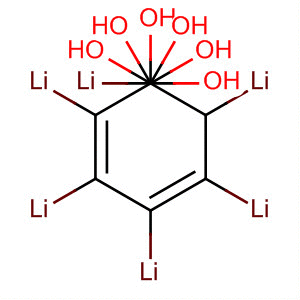Formula C6H6O6 | ||
 | ||
Benzenehexol, also called hexahydroxybenzene, is an organic compound with formula C6H6O6 or C6(OH)6. It is a six-fold phenol of benzene. The product is also called hexaphenol, but this name has been used also for other substances.
Contents

Benzenehexol is a crystalline solid soluble in hot water, with a melting point above 310°. It can be prepared from inositol (cyclohexanehexol). Oxidation of benzenehexol yields tetrahydroxy-p-benzoquinone (THBQ), rhodizonic acid, and dodecahydroxycyclohexane. Conversely, benzenehexol can be obtained by reduction of sodium THBQ salt with SnCl2/HCl.

Benzenehexol is a starting material for a class of discotic liquid crystals.
Benzenehexol forms an adduct with 2,2'-bipyridine, with 1:2 molecular ratio.
Benzenehexolate

Like most phenols, benzenehexol can lose the six H+ ions from the hydroxyl groups, yielding the hexaanion C6O66−. The potassium salt of this anion is one of the components of Liebig's so-called "potassium carbonyl", the product of the reaction of carbon monoxide with potassium. The hexaanion is produced by trimerization of the acetylenediolate anion C
2O2−
2 when heating potassium acetylenediolate K
2C
2O
2. The nature of K
6C
6O
6 was clarified by R. Nietzki and T. Benckiser in 1885, who found that its hydrolysis yielded benzenehexol.
The lithium salt of this anion, Li6C6O6 has been considered for electric battery applications.
Esters

Hexahydroxy benzene forms esters such as the hexaacetate C
6(-O(CO)CH3)6 (melting point 220 °C) and ethers like hexa-tert-butoxybenzene C
6(-OC(CH3)3)6 (melting point 223 °C).
